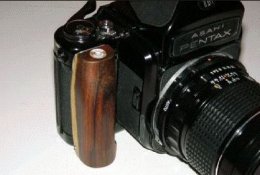I have both systems, as well as a couple 6x6 folders and a 6x6 TLR.
My 645 is a Bronica ETRSi. I bought it at the bottom of the medium format market, some five years ago -- paid $127 for an outfit which included two backs, two lenses and a prism finder. I've since added another 120 back, a metered prism finder, a speed grip, and another lens. The ETRSi is a great system camera, IMO. I really like the fact that it uses leaf-shutter lenses and regular style film backs. It's been a great machine and has taken great photos.
Last year, I bought a Pentax 67. I've wanted one of these monsters for over 30 years, so it was more a matter of dealing with a "want" rather than with a "need." Big difference. Still, it's been a lot of fun shooting with that big thing. And I'm enjoying the fact that prices for outfit items are rather cheap right now, especially most lenses. I have three lenses, wide angle through telephoto, plus a teleconverter. I also sprang for the metered prism finder. It seems to be quite accurate, but I don't know what to think of it yet. To me, the way a meter meters a scene matters a lot to me and I suspect that this one employs just a straight averaging system. But then, so does the ETRSi's, far as that goes. I have a hand-held spot meter if I need to get more precise.
As for differences, that's a good question. I bought the Pentax 67 partly because I just like the idea of having that big 6x7 negative or slide. Quite a bit more emulsion area than a 6x4.5 sized one. An extra 2.5 x 6 = 15 cm if my math is correct, or more than 50% more area over a 6x4.5 negative or slide. That big of a difference has to matter when it comes to making enlargements, it seems to me. But in the real world, chances are the differences may be rather small.
This reminds me of a comparison I was asked to do once by a good friend of mine, who shot large format a lot. One day, he handed me a couple of 8x10 glossy B&W prints and asked me if I could tell which was taken by a 35mm and which was taken by a 4x5. I studied them for a moment then handed them back and indicated which one was taken with the 35mm. He asked how I was able to tell the difference. "The grain," I responded. And that was it -- the only difference I could detect between the two photos was that one had more pronounced grain than the other. The level of detail was the same. Now I don't recall anymore which 4x5 and which lens he used, but it was a decent outfit. As for the 35mm, it was a Leica IIIg with a collapsible 50mm f/3.5 Elmar. Ever since then, my respect for the humble old Elmar has been very high. But something else I came away with from that comparison was that, under the right circumstances, a format can perform well beyond what people give it credit for, given the right techniques and the right gear.
 P6x7 by David Fincher, on Flickr
P6x7 by David Fincher, on Flickr P6x7 by David Fincher, on Flickr
P6x7 by David Fincher, on Flickr












